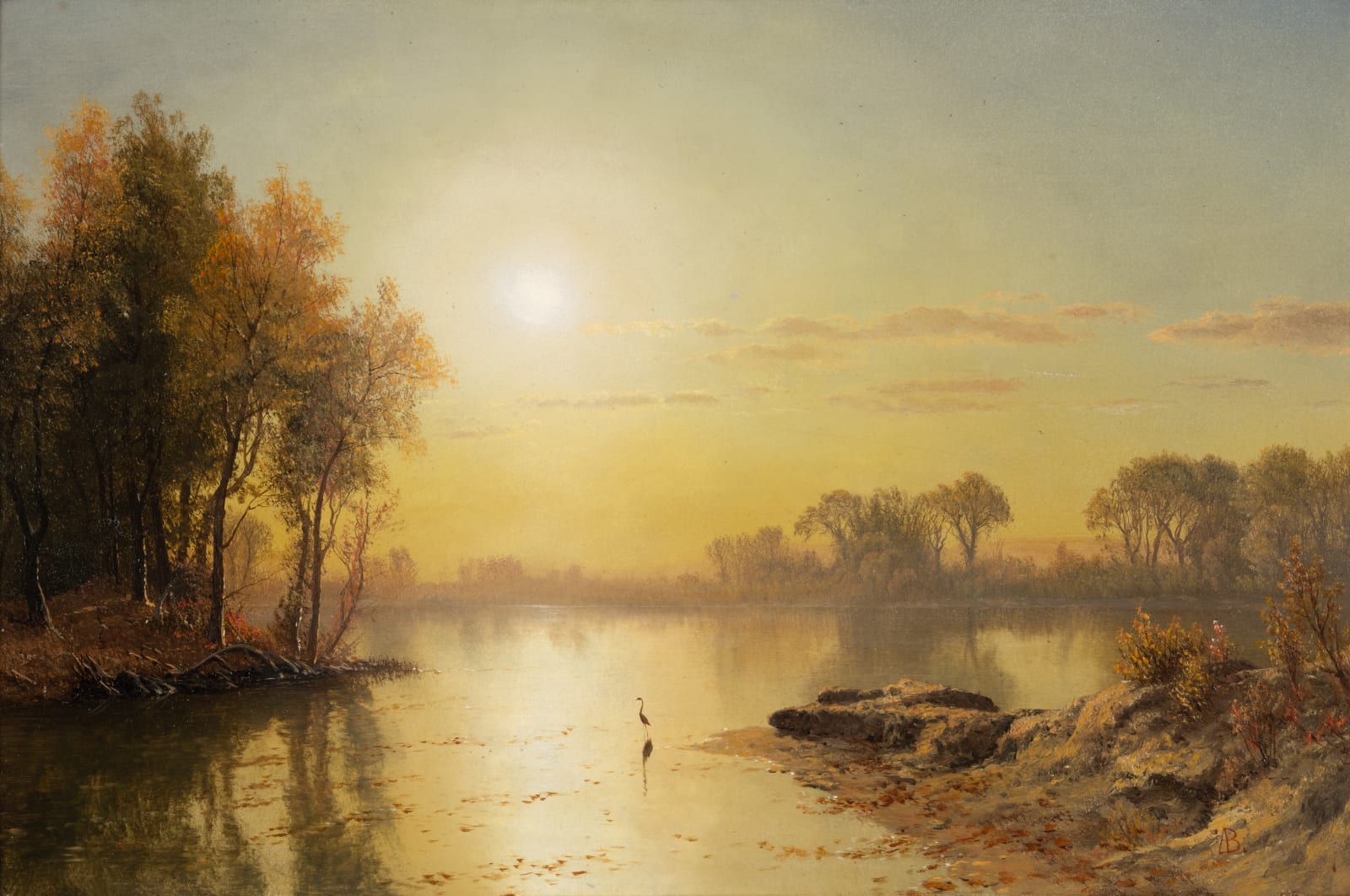-
Albert Bierstadt German, American, 1830-1902
The Heron, undatedOil on panel11¾ x 17¾ inches
29.8 x 45.1 cmSigned with the artist's monogram at lower right: ABSoldAlbert Bierstadt’s paintings may celebrate the splendors of unmistakable sites like the Yosemite Valley or resonate as landscapes of mood and atmosphere where familiar looking, but unspecified terrain and reflecting...Albert Bierstadt’s paintings may celebrate the splendors of unmistakable sites like the Yosemite Valley or resonate as landscapes of mood and atmosphere where familiar looking, but unspecified terrain and reflecting bodies of water are transformed by extraterrestrial phenomena. An aerial glow mirrored in still waters creates an actual but still otherworldly environment that may suggest celestial associations or invoke the venerable eighteenth-century modes of the beautiful and the sublime. Bierstadt is a master of such atmospheric effects not only on a grand scale but also in cabinet paintings such as The Heron and Valley of the Yosemite (1864; Museum of Fine Arts, Boston). In these intimately scaled paintings, the pervasive golden light wields a powerful force uniting terrestrial features into an expression of the visionary. This is not the brilliance of plein-air painting, but rather the radiance of poetic realms.
The tendency in his lifetime, and still today, for critics and art historians, as well as collectors, to focus on the descriptive power of Bierstadt’s style, born of his Dusseldorf training, has obscured the fact that the artist was not immune to influences from other sources. [1] For example, while Thomas Moran earned the sobriquet of “The American Turner,” he was only one of many American artists influenced by the English master. Surely the dramatic golden light with which Bierstadt illuminates works like these is also a nod to that protean artistic force. Additionally, while acknowledging the often remarked upon personal ambition and competitive nature that drove Bierstadt to seek fame and wealth as a self-made man, we should not forget that during his formative early years abroad, he was one of a cohort of talented young American landscape painters who would afterward reunite in New York to become part of the famous Tenth-Street Studio enclave. Among them was Sanford Robinson Gifford, Bierstadt’s colleague and youthful companion in 1857 on a painting tour in Italy. Perhaps the influence of what Kevin Avery has called Gifford’s “signature golden glow” may be recalled in the lyrical mood of The Heron. [2]
—Linda S. Ferber, excerpt from "Small but Sublime: Albert Bierstadt Cabinet Paintings and Oil Studies," 2024
[1] For Bierstadt’s ambition, see Linda Ferber, “The History of a Reputation” in Nancy K. Anderson and Linda S. Ferber et al, Albert Bierstadt: Art & Enterprise (New York: The Brooklyn Museum in association with Hudson Hills Press, 1990), 21-68; for the Tenth Street Studio Building see Annette Blaugrund, The Tenth Street Studio Building: Artist-Entrepreneurs from the Hudson River School to the American Impressionists (Southampton, NY: The Parrish Art Museum, 1997).
[2] For Gifford and Bierstadt, see Kevin J. Avery and Franklin Kelly eds. et al, Hudson River Visions: The Landscapes of Sanford R. Gifford (New York: Metropolitan Museum of Art, 2003).
Provenance
The artist; to
William Godfrey Mayer and Esther Luceta Osborn (the artist’s wife’s sister), Waterville, New York; to
Dr. Edward Randall and Harriet Ada Pauline Mayer (their daughter), Waterville, New York; to
Orville DeForest Edwards and Joyce Edwards (née Randall, their daughter, d. 2000), Dobbs Ferry, New York, until 2000; to
Mr. Orville DeForest Edwards, Dobbs Ferry, New York, 2000–2015;
By descent to private collection, 2015 until the present
Exhibitions
Schoelkopf Gallery, New York, Small But Sublime: Albert Bierstadt Cabinet Paintings and Oil Studies, January 19–February 23, 2024
Subscribe to our mailing list to receive updates from the gallery
* denotes required fields
We will process the personal data you have supplied in accordance with our privacy policy (available on request). You can unsubscribe or change your preferences at any time by clicking the link in our emails.

